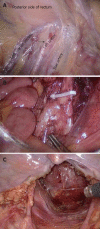Short-term outcomes of laparoscopic total mesorectal excision compared to open surgery
- PMID: 23326138
- PMCID: PMC3544035
- DOI: 10.3748/wjg.v18.i48.7308
Short-term outcomes of laparoscopic total mesorectal excision compared to open surgery
Abstract
Aim: To investigate the short-term outcome of laparoscopic total mesorectal excision (TME) in patients with mid and low rectal cancers.
Methods: A consecutive series of 138 patients with middle and low rectal cancer were randomly assigned to either the laparoscopic TME (LTME) group or the open TME (OTME) group between September 2008 and July 2011 at the Department of Colorectal Cancer of Shanghai Cancer Center, Fudan University and pathological data, as well as surgical technique were reviewed retrospectively. Short-term clinical and oncological outcome were compared in these two groups. Patients were followed in the outpatient clinic 2 wk after the surgery and then every 3 mo in the first year if no adjuvant chemoradiation was indicated. Statistical analysis was performed using SPSS 13.0 software.
Results: Sixty-seven patients were treated with LTME and 71 patients were treated with OTME (sex ratio 1.3:1 vs 1.29:1, age 58.4 ± 13.6 years vs 59.6 ± 9.4 years, respectively). The resection was considered curative in all cases. The sphincter-preserving rate was 65.7% (44/67) vs 60.6% (43/71), P = 0.046; mean blood loss was 86.9 ± 37.6 mL vs 119.1 ± 32.7 mL, P = 0.018; postoperative analgesia was 2.1 ± 0.6 d vs 3.9 ± 1.8 d, P = 0.008; duration of urinary drainage was 4.7 ± 1.8 d vs 6.9 ± 3.4 d, P = 0.016, respectively. The conversion rate was 2.99%. The complication rate, circumferential margin involvement, distal margins and lymph node yield were similar for both procedures. No port site recurrence, anastomotic recurrence or mortality was observed during a median follow-up period of 21 mo (range: 9-56 mo).
Conclusion: Laparoscopic TME is safe and feasible, with an oncological adequacy comparable to the open approach. Further studies with more patients and longer follow-up are needed to confirm the present results.
Keywords: Colorectal surgery; Laparoscopy; Neoplasms; Rectum; Treatment outcome.
Figures
Similar articles
-
[Laparoscopic versus open total mesorectal excision for the middle-lower rectal cancer: a clinical comparative study].Zhonghua Wei Chang Wai Ke Za Zhi. 2009 Nov;12(6):573-6. Zhonghua Wei Chang Wai Ke Za Zhi. 2009. PMID: 19921566 Clinical Trial. Chinese.
-
The circumferential resection margins status: A comparison of robotic, laparoscopic and open total mesorectal excision for mid and low rectal cancer.Eur J Surg Oncol. 2016 Jun;42(6):808-12. doi: 10.1016/j.ejso.2016.03.002. Epub 2016 Mar 23. Eur J Surg Oncol. 2016. PMID: 27038996
-
Robotic versus open total mesorectal excision for rectal cancer: comparative study of short and long-term outcomes.Eur J Surg Oncol. 2014 Sep;40(9):1072-9. doi: 10.1016/j.ejso.2014.02.235. Epub 2014 Feb 26. Eur J Surg Oncol. 2014. PMID: 24646748
-
Laparoscopic total mesorectal excision (TME) for rectal cancer surgery: long-term outcomes.Surg Endosc. 2004 Feb;18(2):281-9. doi: 10.1007/s00464-002-8877-8. Epub 2003 Dec 29. Surg Endosc. 2004. PMID: 14691716 Review.
-
Comparison of short-term clinical outcomes between transanal and laparoscopic total mesorectal excision for the treatment of mid and low rectal cancer: A meta-analysis.Eur J Surg Oncol. 2016 Dec;42(12):1841-1850. doi: 10.1016/j.ejso.2016.09.002. Epub 2016 Sep 19. Eur J Surg Oncol. 2016. PMID: 27697315 Review.
Cited by
-
Incidence trends and predictors for cost and average lengths of stay in colorectal cancer surgery.World J Gastroenterol. 2014 Jan 14;20(2):532-8. doi: 10.3748/wjg.v20.i2.532. World J Gastroenterol. 2014. PMID: 24574722 Free PMC article.
-
Laparoscopic vs. open mesorectal excision for rectal cancer: Are these approaches still comparable? A systematic review and meta-analysis.PLoS One. 2020 Jul 28;15(7):e0235887. doi: 10.1371/journal.pone.0235887. eCollection 2020. PLoS One. 2020. PMID: 32722694 Free PMC article.
-
Outcomes in 132 patients following laparoscopic total mesorectal excision (TME) for rectal cancer with greater than 5-year follow-up.Surg Endosc. 2016 Jan;30(1):307-14. doi: 10.1007/s00464-015-4210-1. Epub 2015 Apr 24. Surg Endosc. 2016. PMID: 25907863
-
Mid- and low-rectal cancer: laparoscopic vs open treatment-short- and long-term results. Meta-analysis of randomized controlled trials.Int J Colorectal Dis. 2022 Jan;37(1):71-99. doi: 10.1007/s00384-021-04048-9. Epub 2021 Oct 29. Int J Colorectal Dis. 2022. PMID: 34716474
-
The comprehensive therapeutic effects of rectal surgery are better in laparoscopy: a systematic review and meta-analysis.Oncotarget. 2017 Feb 21;8(8):12717-12729. doi: 10.18632/oncotarget.14215. Oncotarget. 2017. PMID: 28038460 Free PMC article.
References
-
- Heald RJ, Husband EM, Ryall RD. The mesorectum in rectal cancer surgery--the clue to pelvic recurrence? Br J Surg. 1982;69:613–616. - PubMed
-
- Bach SP, Hill J, Monson JR, Simson JN, Lane L, Merrie A, Warren B, Mortensen NJ. A predictive model for local recurrence after transanal endoscopic microsurgery for rectal cancer. Br J Surg. 2009;96:280–290. - PubMed
-
- Hazebroek EJ. COLOR: a randomized clinical trial comparing laparoscopic and open resection for colon cancer. Surg Endosc. 2002;16:949–953. - PubMed
-
- Fleshman J, Sargent DJ, Green E, Anvari M, Stryker SJ, Beart RW, Hellinger M, Flanagan R, Peters W, Nelson H. Laparoscopic colectomy for cancer is not inferior to open surgery based on 5-year data from the COST Study Group trial. Ann Surg. 2007;246:655–662; discussion 662-664. - PubMed
-
- Day A, Smith R, Jourdan I, Rockall T. Laparoscopic TME for rectal cancer: a case series. Surg Laparosc Endosc Percutan Tech. 2012;22:e98–101. - PubMed
Publication types
MeSH terms
LinkOut - more resources
Full Text Sources


